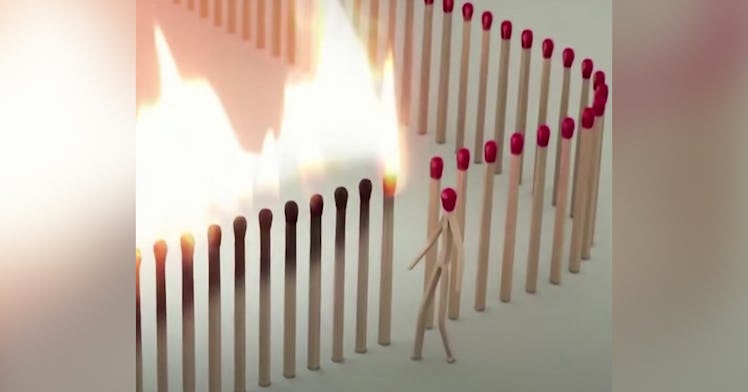These 5 Viral Videos Prove Masks and Social Distancing Work
Still confused about masks and social distancing? Can't be bothered to read? Watch these videos instead.

Although mask mandates have dropped in many public places and many people are returning to life as normal, the COVID-19 pandemic is far from over. New daily COVID cases are up 20 percent compared to two weeks ago with nearly 94,000 people coming down with COVID each day, according to the New York Times COVID Tracker. And with winter weather looming — not to mention Thanksgiving and Christmas on the horizon — the country needs to get those numbers under control. The best way to do this is with vaccination. But besides the COVID vaccine, two of the most effective actions you can take to prevent the spread of COVID are wearing a mask and social distancing in public. Skeptical about just how useful these tactics are? Here’s the proof in five viral videos.
Breathing, Coughing, and Talking Spew Plumes of Particles into the Air
This video from 2011 from researchers in Singapore shows just how far people puff out air when they cough, sneeze, or laugh with and without a mask. Generally, a one-handed save to cover a cough with your hand or elbow doesn’t do enough to stop the flow from your mouth and nose. Using a 4-ply tissue is surprisingly effective, but not if you’re halfway done your cough before you get the Kleenex to your face. The great thing about masks? They’re always ready, though some airflow escapes the edges depending on the fit of your mask.
Ping Pong Balls in Mouse Traps Model Why Social Distancing Works
Staying six feet away from other people while taking the dog for a walk, visiting family, and going to the grocery store doesn’t eliminate the chance of catching or spreading COVID-19, but it does greatly decrease it. This model with ping pong balls and mouse traps shows why. Social distancing isn’t as foolproof as spacing out mouse traps, but the message still stands. And the epic music makes a compelling case too.
“Stay Healthy!” By Wearing a Mask in Public
Researchers at Nebraska Medicine shot laser light at the particles released as a person talks. This shows how far respiratory droplets carrying the coronavirus can travel without a mask. The particles — little green specks that look like mutant venom — travel different distances based on how loudly someone screams at you to “Stay healthy!” After the enthusiastic participant dons a mask, they spout less droplets. Gross, but good.
A Mannequin and a Fog Machine Demonstrate the Power of Cloth Masks
Researchers based out of Florida hooked up a fog machine to a mannequin. They added a pump to push the vapors out of the dummy’s mouth in imitation of a cough. In another glowing green representation — this one more like a lava lamp — the researchers tested different strengths of coughs with varying levels of ventilation in the room. With a single-layer bandana, droplets traveled more than 3.5 feet. A stitched cotton mask reduced droplet travel to less than 2.5 inches. Without a mask, droplets spewed up to 12 feet.
Matchsticks Without “Social Distancing” Burn Like a Fever
In this social distancing metaphor, fire burns down a line of matchsticks like a chain of maskless vacationers passing around COVID-19 at the beach. Then one match with tiny legs steps away from the line of fire, and the flame can’t bridge the distance to the next match. Social distancing is the equivalent of stepping out of the way, stopping the chain of transmission. COVID-19 transmission doesn’t work exactly like this. It’s drawn out over a longer period of time since an infected person is not immediately contagious. But that doesn’t change the fact that you could be asymptomatic, and social distancing reduces your chance of passing on the virus.
This article was originally published on